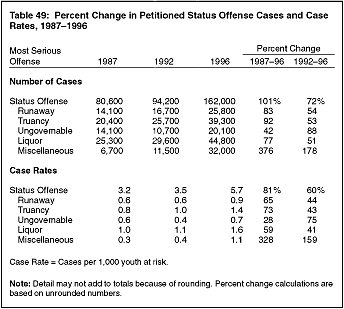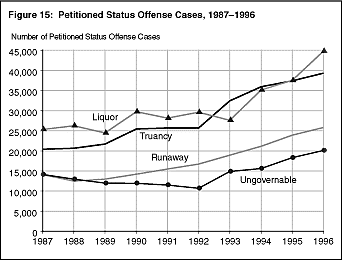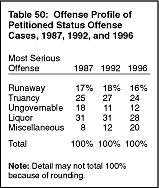|
Status offenses are acts that are illegal only because the person committing them is of juvenile status. In other words, adults cannot be arrested for status offenses. The four major status offense categories used in this Report are running away, truancy, ungovernability (also known as incorrigibility or being beyond the control of one’s parents), and underage liquor law violations (e.g., a minor in possession of alcohol, underage drinking).8
In 1996, U.S. courts with juvenile jurisdiction petitioned and formally disposed an estimated 162,000 status offense cases (table 49).9 This number was 101% more than the number of petitioned status offense cases handled in 1987. Caseloads generally increased between 1987 and 1996 across all four offense categories (figure 15). The number of petitioned truancy cases increased 92%, runaway cases increased 83%, status liquor offense cases increased 77%, and ungovernability cases increased 42%.
The Nation’s juvenile courts processed 5.7 petitioned status offense cases for every 1,000 juveniles in the population in 1996. The case rate for all petitioned status offense cases was 81% higher in 1996 than in 1987. The rate for truancy cases increased 73%, the runaway rate grew 65%, the rate for status liquor law violation cases increased 59%, and the rate for ungovernability cases was 28% higher than in 1987.
In 1996, status liquor law violations accounted for more than one quarter (28%) of formally handled status offense cases, truancy cases for 24%, runaway cases for 16%, ungovernability cases for 12%, and other miscellaneous status offenses for 20% (table 50). Since 1987, liquor law violation and truancy cases have consistently made up a greater share of the status offense caseload than runaway and ungovernability cases.
|


